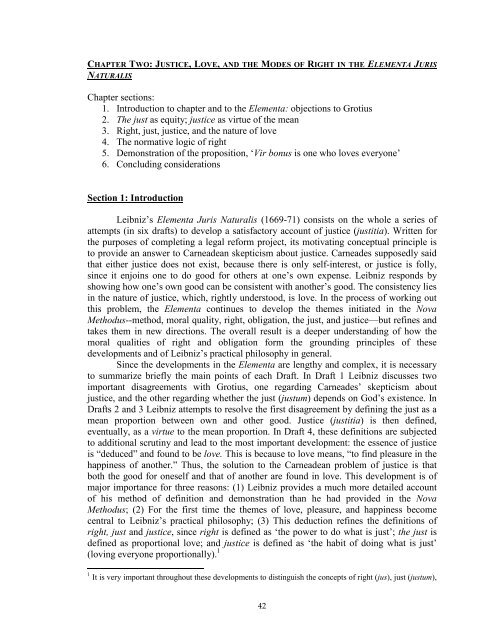Stony Brook University
Stony Brook University
Stony Brook University
Create successful ePaper yourself
Turn your PDF publications into a flip-book with our unique Google optimized e-Paper software.
CHAPTER TWO: JUSTICE, LOVE, AND THE MODES OF RIGHT IN THE ELEMENTA JURIS<br />
NATURALIS<br />
Chapter sections:<br />
1. Introduction to chapter and to the Elementa: objections to Grotius<br />
2. The just as equity; justice as virtue of the mean<br />
3. Right, just, justice, and the nature of love<br />
4. The normative logic of right<br />
5. Demonstration of the proposition, ‘Vir bonus is one who loves everyone’<br />
6. Concluding considerations<br />
Section 1: Introduction<br />
Leibniz’s Elementa Juris Naturalis (1669-71) consists on the whole a series of<br />
attempts (in six drafts) to develop a satisfactory account of justice (justitia). Written for<br />
the purposes of completing a legal reform project, its motivating conceptual principle is<br />
to provide an answer to Carneadean skepticism about justice. Carneades supposedly said<br />
that either justice does not exist, because there is only self-interest, or justice is folly,<br />
since it enjoins one to do good for others at one’s own expense. Leibniz responds by<br />
showing how one’s own good can be consistent with another’s good. The consistency lies<br />
in the nature of justice, which, rightly understood, is love. In the process of working out<br />
this problem, the Elementa continues to develop the themes initiated in the Nova<br />
Methodus--method, moral quality, right, obligation, the just, and justice—but refines and<br />
takes them in new directions. The overall result is a deeper understanding of how the<br />
moral qualities of right and obligation form the grounding principles of these<br />
developments and of Leibniz’s practical philosophy in general.<br />
Since the developments in the Elementa are lengthy and complex, it is necessary<br />
to summarize briefly the main points of each Draft. In Draft 1 Leibniz discusses two<br />
important disagreements with Grotius, one regarding Carneades’ skepticism about<br />
justice, and the other regarding whether the just (justum) depends on God’s existence. In<br />
Drafts 2 and 3 Leibniz attempts to resolve the first disagreement by defining the just as a<br />
mean proportion between own and other good. Justice (justitia) is then defined,<br />
eventually, as a virtue to the mean proportion. In Draft 4, these definitions are subjected<br />
to additional scrutiny and lead to the most important development: the essence of justice<br />
is “deduced” and found to be love. This is because to love means, “to find pleasure in the<br />
happiness of another.” Thus, the solution to the Carneadean problem of justice is that<br />
both the good for oneself and that of another are found in love. This development is of<br />
major importance for three reasons: (1) Leibniz provides a much more detailed account<br />
of his method of definition and demonstration than he had provided in the Nova<br />
Methodus; (2) For the first time the themes of love, pleasure, and happiness become<br />
central to Leibniz’s practical philosophy; (3) This deduction refines the definitions of<br />
right, just and justice, since right is defined as ‘the power to do what is just’; the just is<br />
defined as proportional love; and justice is defined as ‘the habit of doing what is just’<br />
(loving everyone proportionally). 1<br />
1 It is very important throughout these developments to distinguish the concepts of right (jus), just (justum),<br />
42
















